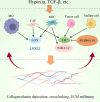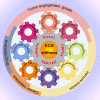Targeting extracellular matrix stiffness and mechanotransducers to improve cancer therapy
- PMID: 35331296
- PMCID: PMC8943941
- DOI: 10.1186/s13045-022-01252-0
Targeting extracellular matrix stiffness and mechanotransducers to improve cancer therapy
Abstract
Cancer microenvironment is critical for tumorigenesis and cancer progression. The extracellular matrix (ECM) interacts with tumor and stromal cells to promote cancer cells proliferation, migration, invasion, angiogenesis and immune evasion. Both ECM itself and ECM stiffening-induced mechanical stimuli may activate cell membrane receptors and mechanosensors such as integrin, Piezo1 and TRPV4, thereby modulating the malignant phenotype of tumor and stromal cells. A better understanding of how ECM stiffness regulates tumor progression will contribute to the development of new therapeutics. The rapidly expanding evidence in this research area suggests that the regulators and effectors of ECM stiffness represent potential therapeutic targets for cancer. This review summarizes recent work on the regulation of ECM stiffness in cancer, the effects of ECM stiffness on tumor progression, cancer immunity and drug resistance. We also discuss the potential targets that may be druggable to intervene ECM stiffness and tumor progression. Based on these advances, future efforts can be made to develop more effective and safe drugs to interrupt ECM stiffness-induced oncogenic signaling, cancer progression and drug resistance.
Keywords: Cancer; Cancer therapy; Drug resistance; ECM stiffness; Extracellular matrix; Mechanotransducer; Piezo.
© 2022. The Author(s).
Conflict of interest statement
The authors declare that they have no competing interests.
Figures



References
-
- Eble JA, Niland S. The extracellular matrix in tumor progression and metastasis. Clin Exp Metastasis. 2019;36(3):171–198. - PubMed
-
- Martins Cavaco AC, Dâmaso S, Casimiro S, Costa L. Collagen biology making inroads into prognosis and treatment of cancer progression and metastasis. Cancer Metastasis Rev. 2020;39(3):603–623. - PubMed
-
- Wang Y, Song EC, Resnick MB. Elastin in the tumor microenvironment. Adv Exp Med Biol. 2020;1272:1–16. - PubMed
-
- Caon I, Bartolini B, Parnigoni A, Caravà E, Moretto P, Viola M, et al. Revisiting the hallmarks of cancer: the role of hyaluronan. Semin Cancer Biol. 2020;62:9–19. - PubMed
Publication types
MeSH terms
Substances
LinkOut - more resources
Full Text Sources
Medical

